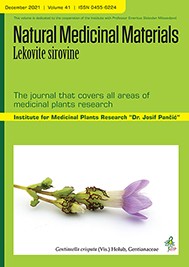Institute for Medicinal Plants Research “Dr. Josif Pančić” , Belgrade , Serbia
Institute for Medicinal Plants Research “Dr. Josif Pančić” , Belgrade , Serbia
Institute for Medicinal Plants Research “Dr. Josif Pančić” , Belgrade , Serbia
Institute for Medicinal Plants Research “Dr. Josif Pančić” , Belgrade , Serbia
Institute for Medicinal Plants Research “Dr. Josif Pančić” , Belgrade , Serbia
Institute for Medicinal Plants Research “Dr. Josif Pančić” , Belgrade , Serbia
Comparison between conventional and microwave-assisted hydrodistillation at different power levels has been applied for the extraction of essential oil from Zingiber officinale Rosc. rhizome. In addition to the collected essential oils, as the main products, hydrolats were also collected, as valuable by-products from both extraction techniques. A comparison of two applied techniques was done in terms of extraction time, extraction yield, the chemical composition of essential oils and hydrolats, and environmental impact. Microwave-assisted hydrodistillation achieved a higher extraction yield (1.70, 1.70, and 1.85 % for power levels of 180, 360, and 600 W, respectively) compared to hydrodistillation (1.50 %). Furthermore, distillation time related to the energy consumption has been reduced from 144 min and 1.44 kWh for conventional hydrodistillation to 37, 32, 27 min and 0.11, 0.19, 0.27 kWh for power levels of 180, 360, and 600 W, respectively. Content of α-zingiberene in essential oil and hydrolat obtained by hydrodistillation was 29.89 and 6.87 %, while content of α-zingiberene in essential oils and hydrolats obtained by microwave-assisted hydrodistillation was higher yielding the amounts of 34.12, 34.43, and 42.00 % and 18.70, 22.60, and 32.92 % for power levels of 180, 360, and 600 W, respectively. Microwave-assisted hydrodistillation has proven to be promising technique for the isolation of ginger’s essential oil regarding improved yield, reduced time and energy requirements, as well CO2 emissions while maintains oil quality.
This is an open access article distributed under the Creative Commons Attribution License which permits unrestricted use, distribution, and reproduction in any medium, provided the original work is properly cited.

The statements, opinions and data contained in the journal are solely those of the individual authors and contributors and not of the publisher and the editor(s). We stay neutral with regard to jurisdictional claims in published maps and institutional affiliations.